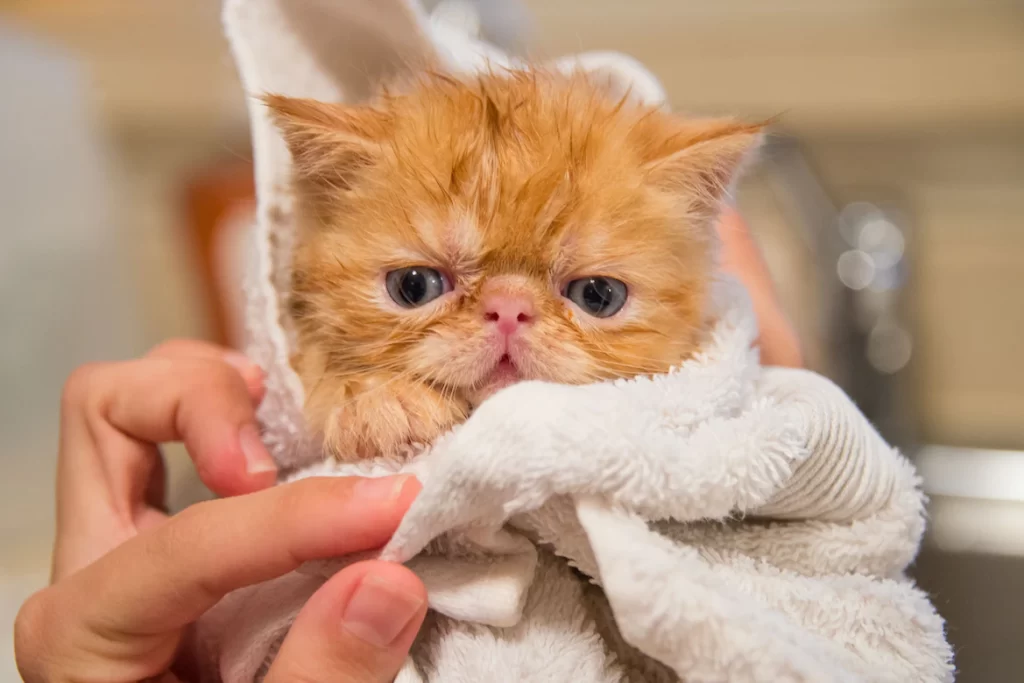Last updated on February 6th, 2023 at 03:40 am

You probably already know that most cats hate getting wet if you’ve had much experience with them. Imagine that you take your cat out to a park for a walk and your cat accidently steps into mud. You are thinking about cleaning him up after but wondering “How to give my cat a bath?” because you have never done it before.
You’re in for a major surprise the first time you try to bathe your cat. This is important to remember if you are a new pet owner. Their nails and claws are so sharp that you will feel the full power of their attack even before you get them in the water, and they may quickly shred your skin to shreds, leaving you bleeding and in pain. Despite their adorable appearance, you will quickly learn that putting them in water brings out the full might of their claws and nails.
Cats don’t need baths very often, but when they do, neither they nor you want to do it. If you need to give your cat a bath, continue reading, and we will walk you through the process in a way that will not put either of you at risk of getting hurt in the process.
How To Give My Cat A Bath?
If you’ve decided that your cat needs to be bathed, these are the steps we recommend you take.
Prepare your cat for a bath
It’s a good idea to warm accustomed to the concept of bathing a cat before attempting anything scary and nerve-racking for you and your cat. Get your cat used to the sights, sounds, and smells associated with bathing. Invite your cat to paw at a trickling of water from the faucet when you’re in the kitchen or bathroom.
Also, clip Kitty’s claws first to prevent her from hurting you if she tries to flee. Check that she is clean and free of matting. Avoid getting the mats damp. It is similar to felting wool and will make removing the mat much more difficult. Fill the bottom of your bathtub or kitchen sink with a rubber mat or a towel. Having something to sink his claws into instead of sliding about makes Kitty feel more comfortable.
Secure Your Cat
We recommend restraining your cat with a harness before informing it that you intend to bathe it. A harness is an excellent way to control your cat’s movements without having to touch it. It also makes catching the cat easier if it starts running. Bath harnesses with chest padding should be avoided, especially if you are washing to eradicate fleas, as cleaning the region below the pad will be difficult.
Choose A Location And A Method
In our experience, cats respond most to a spraying showerhead attachment. It eliminates the need to fill a basin with water and tends to scare the cat less. If the showerhead attachment is not available, you will need to bathe them in a tub, sink, or basin. The tub is typically preferable for full-grown cats, but bathing a kitten may be simpler in one of your sinks or a shallow plastic basin.
Gather Your Supplies
To clean up any water that the cat knocks out of the bath, you’ll need a lot of towels. You’ll also need a towel to dry them off and another to wrap them up once they’re done. Prepare your shampoo, and you may want to wear rubber gloves to protect yourself from scratches. However, the gloves might startle the cat more, but they are useful for preventing injury, especially if you haven’t given the cat many baths before. If you wear gloves, make sure they go up to your elbow.
Fill the basin with water
Fill a tub, sink, or basin halfway with warm water to get it ready. You want it to be warm to the touch as if it were made for a baby.
Insert your cat into the basin
To give your cat a bath, first place your cat gently in the water. You should move quickly but calmly and softly, moisten the fur with clean water, or rinse them with the shower attachment. Keep them in place with the harness rather than your hands to avoid damage. A second person will be useful in this situation.
Shampoo their hair
Moving swiftly, apply the shampoo over your cat’s body and head, taking care not to get any in their eyes.
Please, no shampoo for people
When you give your cat a bath, make sure that you don’t use human shampoos. Shampoos for humans are designed for our hair, not the scalp, but cat shampoos are designed for the scalp, which is more sensitive than the human scalp. A light wash, such as baby shampoo, can help, but it might also dry up your cat’s skin. As the type of cat shampoo required varies depending on the reason for bathing, consult your veterinarian. A medicated shampoo, for example, differs from a regular washing shampoo.
Rinse
Once the shampoo has formed a lather, use the sprayer or a small cup to rinse it from your cat’s body gently. Before taking the cat out of the water, ensure you’ve removed all the soap.
Dry with a towel
Dry off your cat as best you can, and use a clean towel. Once again, the harness is the most effective method of keeping the cat in position while you operate. Once you’ve removed most of the water, wrap them in another dry towel and hold the cat for as long as it will enable absorbing more moisture.
Allow to air dry
When the cat has had enough of being carried, you can let it go and remove the leash. It will most likely flee to groom itself and return in an hour looking for a treat. It, like you, undoubtedly deserves one.
An Additional Reminder When You Give Your Cat A Bath
Some cats dislike quick movements and prefer it if you move slowly around them in the bathtub. Wash your cat gently and speak to him calmly. Do not use a hose to shower your cat. Instead, use a warm, water-dipped hand to scoop the water over your kitten carefully. Scoop a bit at a time until all of his furs are wet. Ensure no water or soap enters your cat’s eyes, ears, or nose.
With flea shampoo, you want a good lather. Continue rubbing the lather for three to five minutes, avoiding the region around the eyes. Your cat will be overjoyed with the massage! Follow the directions carefully, and don’t leave the shampoo on longer than required. If the bathroom doors are closed, and there is nowhere for him to hide, you can pull your cat out of the bathtub and replenish the lukewarm water within those few minutes. If you’re using small tubs, mix in additional warm water to keep the water at a pleasant temperature. Keep an eye on him to prevent him from licking himself.
How to Bathe a Cat who Hates Water?
If a cat dislikes water, you should try to get him or her to drink it. Some cats may take time to realize that the bathwater will not harm them before jumping in. It is advisable to begin by soaking his paws so that he can gradually become accustomed to the concept of receiving a bath. You might also encourage him to become accustomed to the sound of running water by keeping him in the bathroom with you while you take a shower or bath.
If his paws start to become wet, feed him some snacks. You may even try completely submerging one of his toys. It’s possible that this will pique his interest when he sticks his paw into it, revealing that it’s not as frightening as he first believed. Some cats will become more tolerant of water over time, while others will require a little additional prodding and encouragement when bathed.
What Shouldn’t You Do When Bathing Your Cat?
- Restraints such as “Cat bags” or grooming tethers should not be used. The lack of control in an already unusual situation will cause Kitty to panic.
- Scruffing. Scuffing is frequently advocated as a suitable technique for cats since it mimics how their mothers carry them as kittens. On the other hand, mother cats do not carry older kittens or cats in this manner. Scruffing is aggressive behavior in cats that has progressed beyond kittenhood. In nature, cats would only be handled in this manner by a predator or during mating. It’s not soothing. Scruffing is occasionally required in an emergency, such as when dealing with a feral cat, a cat in distress, or an angry cat. There are far better ways to bathe your pet regularly.
- Scream, yell, and panic out. You’ll only frighten her. The worst thing you can do is lose control. Kitty is counting on you to keep her together.
- Make it a punishment. You want bathing and grooming to be pleasurable experiences.
Assist Your Cat in Getting Used to Bathing, So She Doesn’t Scratch You
- Begin early. If you have an adult cat, you may encounter more opposition. If possible, take the time to train Kitty to tolerate bathing. Allow him to experiment with dripping water in the sink or tub.
- Put a motorized fish toy or some ping pong balls in a shallow tub of water. If the tub isn’t appealing, use a hefty, large casserole dish.
- Allow Kitty to have fun in the dry bathtub. Then add a little water to familiarise her with the sensation on her paws.
- Wipe her down with a damp washcloth to familiarize her with the feel of water in her coat.
- Don’t punish her with a water spray bottle. Not only is it useless, but she will not associate water with a pleasant experience.
How Frequently Should I Bathe My Cat?
If you asked your cat how often you should give it a bath, it would most likely respond never, and you would be surprised to learn that we both technically agree. Cats are highly clean animals who methodically bathe themselves for a large chunk of the little time they are awake each day, despite the massive mess they prefer to make around the litter box. If a cat does not groom itself, it is usually a symptom of a health condition, and you should take it to the doctor to be examined. Bathing a healthy cat should be done sparingly, if at all.
Why should a cat be cleaned?
Cats have a well-developed set of grooming skills, allowing them to maintain a high level of personal cleanliness. Nevertheless, cat owners will find themselves in the following situations where they must know how to bathe their pets properly. The aching joints caused by arthritis prevent older cats from grooming themselves as thoroughly as they once did, and certain cats require a bath with flea shampoo that contains medication. Curious cats are especially prone to getting into smelly situations. Here is a detailed explanation of why you should bathe your cat.
Fleas
It may surprise you to learn that even indoor cats can develop fleas. Fleas can jump on your clothing while you’re out for a stroll and end up on your cat when you get home. Fleas will infest outside cats regularly, posing a continual threat to your cat’s life. If your cat lives outside, we recommend a full flea treatment like Frontline since it is considerably more effective and also treats heartworm, which is common in outdoor cats and can be fatal. If your indoor cat has fleas, you may get rid of them with flea shampoo, which will require you to bathe your cat.
Also read: Natural Ways To Get Rid Of Fleas On Cats
Cats with no fur
Sphinx, Peterbald, Donskoy, Bambino, and other hairless cat breeds have oil on their skin that must be washed regularly. These oils would ordinarily coat the cat’s hair as it grew and be groomed away, but in the case of these animals, they cause a buildup on the skin. As the cat moves, these oils will rub off on your furniture and clothing and begin to smell. To clean hairless cats, bathe them once a week using a gentle, natural shampoo. There are numerous brands to choose from, and you may need to test a few to find one that you both enjoy.
Encounter with a Skunk
A very rare situation, but if you live in an area where encountering a skunk can happen every day, this will cause your cat’s hygiene problems. If your cat encounters a skunk, it will most certainly require a bath. You’ve probably heard thousands of methods for getting the stench off your pet, ranging from baking soda to tomato juice, but they all involve placing your cat in the tub. Because tomato juice can be fairly messy, especially with a cat, we recommend a good shampoo with a sprinkling of baking powder.
Other Factors
Your cat may also wander through mud, chemicals, paint, or something they cannot or do not want to clean themselves. In this instance, bathing will be required to clean them.
Conclusion
Bathing your cat will be an unforgettable event for you and your cat, but the cat harness and shower attachment can go much more smoothly than with a tub of water and rubber gloves. Some cats don’t mind getting a bath, and if you do it every few months, starting at birth, they may grow accustomed to it. However, most cats don’t require a wash, so there’s no use in putting you both through it unless absolutely essential. In that situation, act swiftly and follow this guide. We hope you liked reading and are now more at ease with this seemingly hard undertaking.


